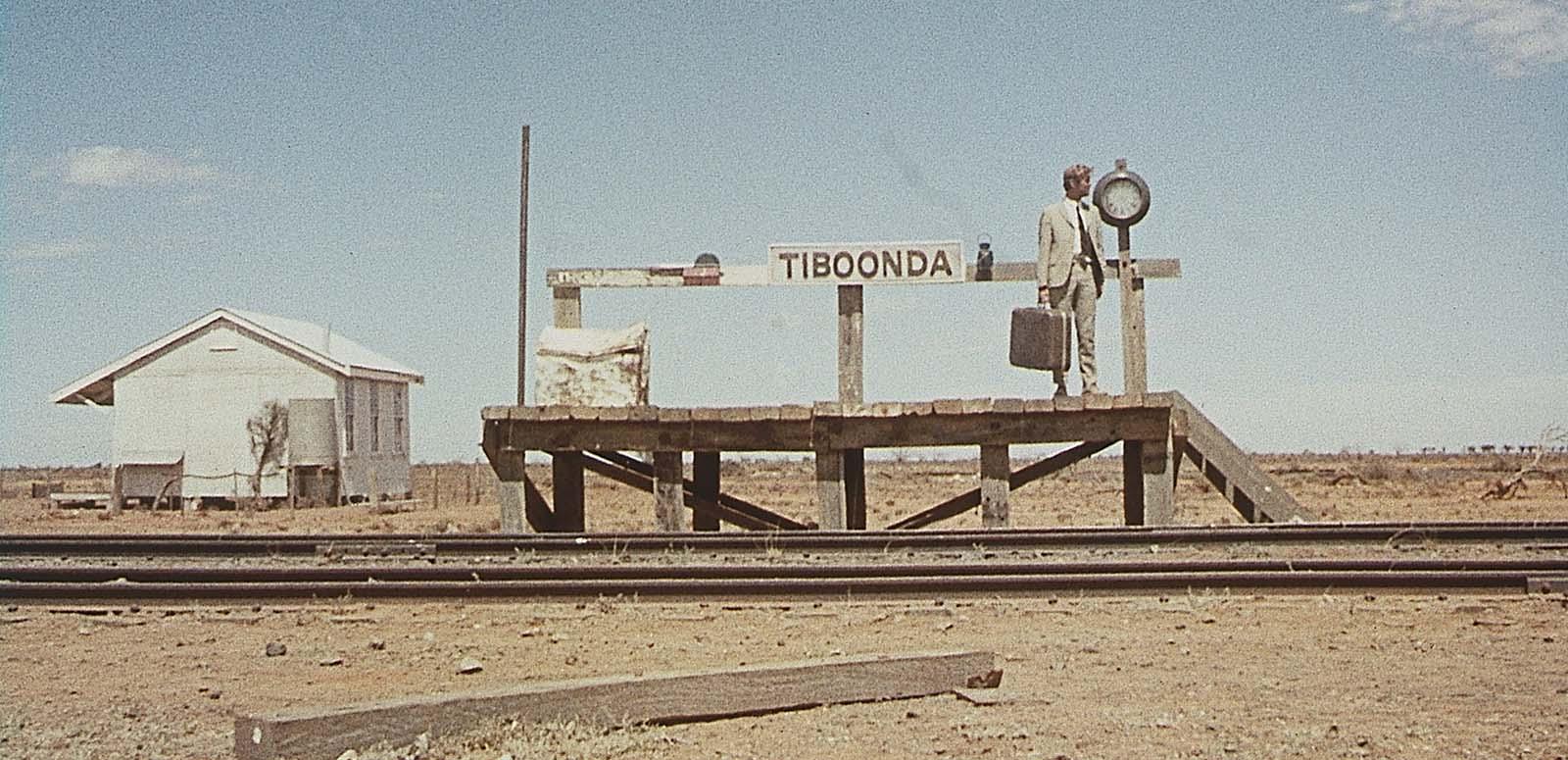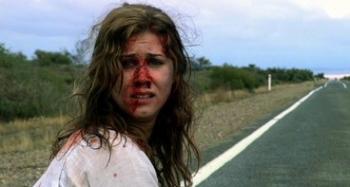Graham Shirley traces the rich diversity of Australian cinematic representations and interpretations of the outback.
Read Outback on screen part one: taming the landscape

Graham Shirley traces the rich diversity of Australian cinematic representations and interpretations of the outback.
Read Outback on screen part one: taming the landscape
In the mid-to-late 1910s, at the same time as Australia’s earliest outback humour appeared on screen, the outback itself was likely to be seen mostly in romantic and nostalgic terms. Already by 1891, when 70 per cent of Australia’s 3.2 million people lived in cities and suburbs, city dwellers nurtured a strong, idealistic nostalgia for the bush and outback. Rural stage dramas like The Breaking of the Drought (premiered onstage in 1893) and comedies like On Our Selection (premiered in 1912) were invariably popular on stage and screen. According to their myth-making, the outback conferred beauty, serenity and nobility onto those who lived in it, while the city was associated with corruption, squalor and disorientation.
Filled with outback-versus-city differences, The Breaking of the Drought (1920) positions its farming family, the Galloways, as staunch, honourable and stoic when confronted by the drought that sees a bank take possession of their sheep property. City dwellers, by contrast, including the Galloways’ son, are presented as people whose corruption and parasitic ways can only worsen the country-dweller’s plight. The drought eventually breaks, restoring the Galloways’ money, but the outback scenes in Drought – scenes that saw the film banned for export – included documentary coverage of a severe drought that director-cameraman Franklyn Barrett filmed in northern New South Wales in 1919, showing hungry sheep being fed grain and tree branches, and dead sheep feasted on by crows. Such realistic starkness was rare in Australian silent cinema, and only the drought scenes in Raymond Longford’s naturalistic version of On Our Selection (1920) came close.
Even a film as cinematically groundbreaking as Walkabout (Nicolas Roeg,1970) draws on the old contrasts between the jaded-city-versus-purifying-outback as two white schoolchildren, lost in desert country after the suicide of their city-stressed father, embark on an epic journey back to civilisation guided by an Aboriginal teenager (David Gulpilil). While the girl, played by Jenny Agutter, rejects possibilities to stay in the outback, it is clear that her younger brother (Lucien John) has a stronger affinity with the spirit of the landscape through which they have travelled.
In recent decades more Australian films have dealt with the white person’s disconnectedness with the outback. Ross Gibson has written: ‘The idea of the intractability of Australian nature has been an essential part of the national ethos. It is a notion with its genesis in the ancient legends of the hellish antipodes; a notion promoted by the First Fleet annalists who detailed the anguish of a harrowed and perverse society struggling to understand and subsist in a seemingly bizarre habitat.’
Idealised though it was by some films, in others the outback was an untameable place that punished white attempts at cultivation with the revenge of bushfire, flood and drought (see also Paul Byrnes’s essay Water in Australian cinema). The Squatter’s Daughter (1933), based on a long-running stage play, climaxes with a ferocious bushfire that carries away the villains while reuniting hero and heroine. Sons of Matthew (1949) climaxes with a cyclone, Newsfront (Phillip Noyce, 1978) with a devastating flood, and the short film Dust (Ivan Sen, 2000) with an immense, pulverising outback dust storm that negates the human conflict that has just erupted. Dust, hauntingly invested with Indigenous themes, also suggests how a location’s memory of past events can influence the present.

Natural disaster has not only challenged Australian film characters since the 1910s but has also forced many – in life as well as on screen – to abandon their properties. In 1974 Richard Mason made the docu-drama Moving On, about a grazier who re-settles in the city after prolonged drought and a fall in wool prices. Made two decades later, David Elfick’s feature No Worries (1994) focuses on one family among many in a single outback district who again have to abandon their property to drought. Moving to the city, the family become economic refugees whose plight is compared to that of similar recent arrivals, this time from Asia. The film benefits by focusing its story on Matilda, an 11-year-old girl from whose perspective we see the landscape shrivelling beneath the sun.
If the outback wasn’t able to burn, flood or blow its inhabitants away, in a number of films it made them vanish, symbolising that white settlers have never quite belonged to such an alien land. Lost explorers featured in two films (made in 1918 and 1985) about the colonial outback explorers Burke and Wills. Even a film as light as The Adventures of Priscilla, Queen of the Desert (Stephan Elliott, 1994) lost its busload of city drag queens in a desert lunarscape gigantic enough to present a brooding, albeit temporary threat.
The theme of a child lost in the bush appeared as early as The Woman Suffers (Raymond Longford, 1918), and the documentary The Back of Beyond (1954) told of two children getting lost in a limitless desert as they re-cross their own tracks in search of their father. The sequence, dreamily accompanied by the younger girl playing a flute, is made all the more wrenching by the older girl concealing the significance of their disorientation as they continue into unending dune country.
From the 1970s lost children became more of a tradition in outback cinema. Picnic at Hanging Rock (Peter Weir, 1975) is the eeriest articulation of this, with its disappearance of Victorian-era schoolgirls implying that Europeans unable to adapt to the outback should either stay away from it or face the consequences. Shot at the immense Hanging Rock monolith in central Victoria, the film draws much of its power from the dissonance between the soon-to-be vanished girls and the other-worldly setting of the rock’s multiple levels, labyrinthine pathways and tunnels. Just as the Joan Lindsay novel from which the film was adapted offered no explanation for the girls’ disappearance, nor does the film.

Wolf Creek (Greg McLean, 2005), based on fact, takes the spirit of a malign Australian landscape to even greater extremes. Having visited an outback meteor crater called Wolf Creek, the story’s three young travellers are stranded when an uncanny electrical force disables their car, setting them up for their fateful meeting with a serial killer. The killer proves to be as at ease in this lonely, unlovely landscape as his victims are alien to it. When one of the travellers escapes, the region’s remoteness continues to conspire by delivering no outside help until it is far too late.
While a horror film, Wolf Creek (2005) starts deceptively as a relaxed and naturalistic road movie, and for a while it seems that is all it will be. Road movies were not thick on the ground in early Australian cinema but from the late 1970s they took hold as a genre with the success of all three of the Mad Max films Mad Max (George Miller, 1979), Mad Max 2 (George Miller, 1981) and Mad Max beyond Thunderdome (George Miller and George Ogilvie, 1985), the second and third of which used the outback for journeys into a barbarous future.
Mad Max 2 (1981) made the series’ most vivid use of Australian landscape, and its terrain (filmed near Broken Hill, NSW, which had also provided locations for Wake in Fright ten years before) is other-worldly and unknowable. But the film also captures limitless flat, red, stony desert expanses that are a logical battleground for a future lawless society.

Outback road movies of a more deeply searching kind continue to be made, and the best of them have used the physical journey to match its characters’ states of mind. A number of them have had Aboriginal themes, like Backroads (Phillip Noyce, 1977), which explores white responsibility for Aboriginal poverty, and Wrong Side of the Road (Ned Lander, 1981), charting young Aboriginal rock musicians’ clashes with racism.
Beneath Clouds (Ivan Sen, 2002) leaves the strongest impression by taking its time to quietly invite the audience to observe the interaction between the landscape and its teenage Aboriginal protagonists, Lena (Dannielle Hall) and Vaughan (Damian Pitt), an escapee from a juvenile detention centre. Both are headed for Sydney in search of connections with family members they hope will broaden their horizons. The film’s most memorable outback landscapes are serene, magical, glowing places that appear to be teasing out the characters’ moments of realisation.
Films about, or set in, the outback have been central to a ‘dreaming’ of Australia. In his documentary 40,000 Years of Dreaming: A Century of Australian Cinema (1996) George Miller (director of the Mad Max films) suggests that white filmmakers have used the medium of cinema to spirit their country into being in the way that Aboriginal creation myths had done before white settlement.
Constantly evolving, the outback film has brought Aboriginal people from the observed to observers, has traced the history of white men and white women seeking to tame, work at or at least mine the outback for its complex, often contradictory symbols, and has continued to use this landscape for meditations on, or journeys into, romance, fear and self-realisation.
Without the outback, Australian cinema might have been interchangeable with any number of other national cinemas. With it, Australian filmmakers have used the landscape to forge an identity that is of the land, while still seeking to understand its enigma.
This essay was also published in the National Museum of Singapore’s Cinematheque Quarterly and on australianscreen to coincide with The Outback on Screen, a lecture given at the museum by Graham on 9 August 2011.
Gibson, R ‘Formative Landscapes’ in Murray, S (ed.) 1988, Back of Beyond: Discovering Australian Film and Television, Australian Film Commission, Sydney
Gibson, R 1992, South of the West: Postcolonialism and the Narrative Construction of Australia, Indiana University Press, Bloomington
The National Film and Sound Archive of Australia acknowledges Australia’s Aboriginal and Torres Strait Islander peoples as the Traditional Custodians of the land on which we work and live and gives respect to their Elders both past and present.